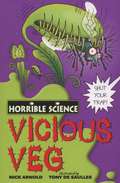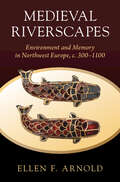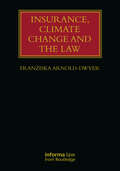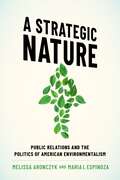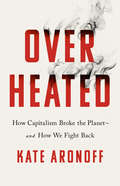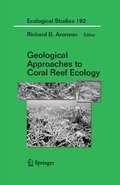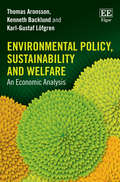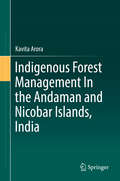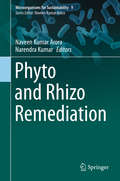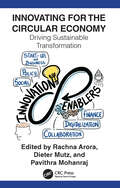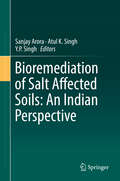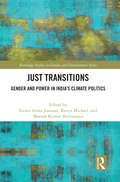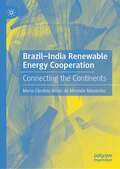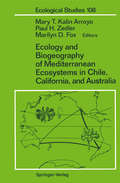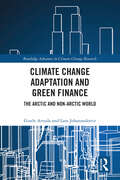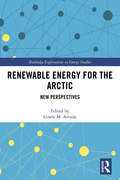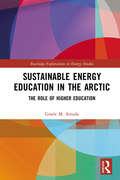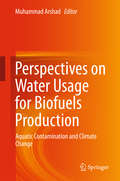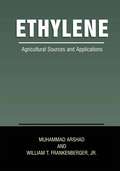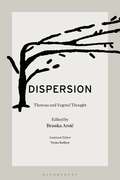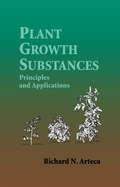- Table View
- List View
Vicious Veg (PDF)
by Nick Arnold Tony De SaullesScience with the squishy bits left in! How do plants suck out the insides of dead insects? Why do stinging nettles like skeletons? Which fungi can make your toes drop off? Get the awful answers in Vicious Veg!
Medieval Riverscapes: Environment and Memory in Northwest Europe, c. 300–1100 (Studies in Environment and History)
by null Ellen F. ArnoldFishermen, monks, saints, and dragons met in medieval riverscapes; their interactions reveal a rich and complex world. Using religious narrative sources to evaluate the environmental mentalities of medieval communities, Ellen F. Arnold explores the cultural meanings applied to rivers over a broad span of time, ca. 300-1100 CE. Hagiographical material, poetry, charters, chronicles, and historiographical works are explored to examine the medieval environmental imaginations about rivers, and how storytelling and memory are connected to lived experiences in riverscapes. She argues that rivers provided unique opportunities for medieval communities to understand and respond to ecological and socio-cultural transformations, and to connect their ideas about the shared religious past to hopes about the future.
Insurance, Climate Change and the Law (ISSN)
by Franziska Arnold-DwyerThe insurance industry has found itself at the front line of climate change challenges, providing insurance cover in relation to risks associated with climate change. As risk carriers, insurers pay claims for climate change related losses – such as property damage caused by windstorms, flooding, and wildfires – which have been increasing in frequency and severity.As major institutional investors, insurance companies invest in assets that may be increasingly vulnerable to climate risks. Insurance regulators across the globe have therefore started to require insurance companies to identify, manage, and report on climate change risks that could pose a threat to their financial stability. However, managing and reporting on the effect of climate risk on an insurer’s balance sheet is an inward-looking perspective that does not stem climate change. It needs to be paired with an outward-looking perspective that takes account of the insurance industry’s impact on the environment and the insurance industry’s capacity to influence what policyholders, investee enterprises, and other business partners do to address climate change challenges. For the insurance industry, the key components of positive outward impact are ‘impact underwriting’ and ‘impact investment.’ This book sets out the current legal and regulatory landscape for impact underwriting and impact investment. Whilst the focus of research and regulatory interventions to date has been on inward impact, in this book it will be argued that, to take positive climate action that supports the Paris Agreement goals and the national and international Net Zero targets, the debate should now move on to considering the positive outward impact the insurance industry can make and how we can create a legal environment to facilitate this.The book puts forward the case for a new vision of the role of the insurance industry as climate action enablers and makes proposals for insurance products and risk transfer and loss resilience structures that can support policyholders in their transition to a Net Zero economy. The audience for this book will include legal practitioners, insurance industry professionals, financial and insurance regulators, policymakers, and interested academics.
Insurance, Climate Change and the Law (ISSN)
by Franziska Arnold-DwyerThe insurance industry has found itself at the front line of climate change challenges, providing insurance cover in relation to risks associated with climate change. As risk carriers, insurers pay claims for climate change related losses – such as property damage caused by windstorms, flooding, and wildfires – which have been increasing in frequency and severity.As major institutional investors, insurance companies invest in assets that may be increasingly vulnerable to climate risks. Insurance regulators across the globe have therefore started to require insurance companies to identify, manage, and report on climate change risks that could pose a threat to their financial stability. However, managing and reporting on the effect of climate risk on an insurer’s balance sheet is an inward-looking perspective that does not stem climate change. It needs to be paired with an outward-looking perspective that takes account of the insurance industry’s impact on the environment and the insurance industry’s capacity to influence what policyholders, investee enterprises, and other business partners do to address climate change challenges. For the insurance industry, the key components of positive outward impact are ‘impact underwriting’ and ‘impact investment.’ This book sets out the current legal and regulatory landscape for impact underwriting and impact investment. Whilst the focus of research and regulatory interventions to date has been on inward impact, in this book it will be argued that, to take positive climate action that supports the Paris Agreement goals and the national and international Net Zero targets, the debate should now move on to considering the positive outward impact the insurance industry can make and how we can create a legal environment to facilitate this.The book puts forward the case for a new vision of the role of the insurance industry as climate action enablers and makes proposals for insurance products and risk transfer and loss resilience structures that can support policyholders in their transition to a Net Zero economy. The audience for this book will include legal practitioners, insurance industry professionals, financial and insurance regulators, policymakers, and interested academics.
A Strategic Nature: Public Relations and the Politics of American Environmentalism
by Melissa Aronczyk Maria I. EspinozaA look at how public relations has dominated public understanding of the natural environment for over one hundred years. In A Strategic Nature, Melissa Aronczyk and Maria I. Espinoza examine public relations as a social and political force that shapes both our understanding of the environmental crises we now face and our responses to them. Drawing on in-depth interviews, ethnography, and archival research, Aronczyk and Espinoza document the evolution of PR techniques to control public perception of the environment since the beginning of the twentieth century. More than spin or misinformation, PR affects how institutions and individuals conceptualize environmental problems -- from conservation to coal mining to carbon credits. Revealing the linkages of professional strategists, information politics, and environmental standards, A Strategic Nature shows how public relations restricts alternative paths to a sustainable climate future.
A Strategic Nature: Public Relations and the Politics of American Environmentalism
by Melissa Aronczyk Maria I. EspinozaA look at how public relations has dominated public understanding of the natural environment for over one hundred years. In A Strategic Nature, Melissa Aronczyk and Maria I. Espinoza examine public relations as a social and political force that shapes both our understanding of the environmental crises we now face and our responses to them. Drawing on in-depth interviews, ethnography, and archival research, Aronczyk and Espinoza document the evolution of PR techniques to control public perception of the environment since the beginning of the twentieth century. More than spin or misinformation, PR affects how institutions and individuals conceptualize environmental problems -- from conservation to coal mining to carbon credits. Revealing the linkages of professional strategists, information politics, and environmental standards, A Strategic Nature shows how public relations restricts alternative paths to a sustainable climate future.
Overheated: How Capitalism Broke the Planet--And How We Fight Back
by Kate AronoffThis damning account of the forces that have hijacked progress on climate change shares a bold vision of what it will take, politically and economically, to face the existential threat of global warming head-on.In the past few years, it has become impossible (for most) to deny the effects of climate change and that the planet is warming, and to acknowledge that we must act. But a new kind of denialism is taking root in the halls of power, shaped by a quarter-century of neoliberal policies, that threatens to doom us before we've grasped the full extent of the crisis.As Kate Aronoff argues, since the 1980s and 1990s, economists, pro-business Democrats and Republicans in the US, and global organizations like the UN and the World Economic Forum have all made concessions to the oil and gas industry that they have no intention of reversing. What's more, they believe that climate change can be solved through the market, capitalism can be a force for good, and all of us, corporations included, are fighting the good fight together.These assumptions, Aronoff makes abundantly clear, will not save the planet. Drawing on years of reporting and rigorous economic analysis, Aronoff lays out a robust vision for what will, detailing how to constrain the fossil fuel industry; transform the economy into a sustainable, democratic one; mobilize political support; create effective public-private partnerships; enact climate reparations; and adapt to inevitable warming in a way that is just and equitable.Our future, Overheated makes clear, will require a radical reimagining of our politics and our economies, but if done right, it will save the world.
Geological Approaches to Coral Reef Ecology (Ecological Studies #192)
by Richard B. AronsonThis book provides a unique perspective on the destruction - both natural and human-caused - of coral reef ecosystems. Reconstructing the ecological history of coral reefs, the authors evaluate whether recent dramatic changes are novel events or part of a long-term trend or cycle. The text combines principles of geophysics, paleontology, and marine sciences with real-time observation, examining the interacting causes of change: hurricane damage, predators, disease, rising sea-level, nutrient loading, global warming and ocean acidification. Predictions about the future of coral reefs inspire strategies for restoration and management of ecosystems. Useful for students and professionals in ecology and marine biology, including environmental managers.
Environmental Policy, Sustainability and Welfare: An Economic Analysis
by Thomas Aronsson Kenneth Backlund Karl-Gustaf LöfgrenThis comprehensive and accessible textbook addresses important relationships between economics and environmental policy, highlighting in particular the role of taxation. It also connects environmental policy to social accounting by describing how measures of welfare and sustainable development depend on whether policies successfully internalize market failures. The authors discuss how the modern literature on environmental taxation and tradable permits has evolved. Environmental taxation is examined from a purely corrective perspective, and as part of a broader system of optimal taxation that reflects distributional objectives. Cost benefit rules of environmental policy reforms are also examined in various contexts. Key features include: • Examination of optimal tax policy in static and dynamic general equilibrium models with environmental externalities • Examination of cost benefit rules for environmental policy reforms • Essential historical background to the modern literature on environmental policy • Discussion of measures of welfare and sustainable development • Environmental policy from a fiscal federalism perspective. This textbook will be essential reading for those studying environmental economics and environmental policy, working effectively as both an in-depth supplementary text in general courses on environmental economics and a strong main source for environmental policy courses.
Indigenous Forest Management In the Andaman and Nicobar Islands, India
by Kavita AroraThis book offers an extensive study of indigenous communities in the Andaman and Nicobar Islands, India, and their methods of forest conservation, along with an exploration of the impact of forestry operations in the islands and the wide scale damage they have incurred on both the land and the people. Through an in-depth analysis of the contrasting indigenous practices and governmental forestry schemes, the author has compared the modern ‘Joint Forest Management’ resolution with the ethos and practices of the indigenous people of the Andaman and Nicobar Islands. Throughout the book, readers will learn about the different indigenous communities inhabiting these islands and the treasure of knowledge each of them provide on forest conservation. The book establishes that the notion of knowledge is politicized by the dominant culture in the context of Andaman’s forest tribes, and traces how this denial of the existence of indigenous knowledge by government officials has led to reduced forest area in the region. The book also explores and analyses strategies to utilize and conserve the tribes' profound knowledge of the biodiversity of the islands and study their efforts towards forest conservation, protection and rejuvenation.
Phyto and Rhizo Remediation (Microorganisms for Sustainability #9)
by Naveen Kumar Arora Narendra KumarThe increasing human population and the associated activities have negatively influenced the ecosystems and life on earth. The continuous addition of agrochemicals, heavy metals and industrial wastes/ effluents in the ecosystems have caused great harm, including loss of productivity, biodiversity, climate change and diseases in plants, animals and humans, resulting in increased marginal lands and endangered sustainability of life on earth. Hence, there is an urgent need to reverse the impact of dangerous pollutants through a holistic, sustainable and biotic approach. Bioremediation involves the utilization of biological systems, mainly plants (phytoremediation) or microorganisms or both in combination (rhizoremediation) for the removal or degradation of pollutants and revive the habitats in an eco-friendly manner. Recently, there have been many success stories related to bioremediation involving plants or plant-microbe interactions. These success stories are related to the removal of heavy metals, pesticides, polyaromatic hydrocarbons, explosives, radionuclides or reduction of biological oxygen demand, total dissolved solids, total suspended solids, oil spills in water bodies. Rhizoremediation has also been successfully used for reclamation of saline or marginal soils. With the range of pollutants and the total area (on earth) covered by these toxic chemicals, it is important that these eco-friendly technologies be utilized in a better way. The book throws light on the recent happenings, research and success stories related to bioremediation of polluted habitats through phytoremediation or rhizoremediation. The book also highlights some of the significantly important plant and microbial species involved in remediation, the physiology, biochemistry and the mechanisms of remediation by various plants and microbes, and suggestions for future improvement of bioremediation technology.
Innovating for The Circular Economy: Driving Sustainable Transformation
by Rachna Arora Dieter Mutz Pavithra MohanrajSystemic change is required to move to a circular economy (CE) model which can meet the demands of a growing population in a manner that is decoupled from resource use and waste generation. This book takes a deep dive into the innovation aspect of the circular economy (CE), with a specific focus on India as a geography, where the transformation to a circular economy is underway. How a developing country like India is tackling the complexities of the transformation and creating innovative solutions is showcased in this book through many practical examples and inspirational case studies. The book lays out the foundations for mainstreaming resource efficiency (RE)/CE in India, and covers innovation led by businesses and start-ups, along with the innovative policies, financing, and collaborative models required to spur and accelerate circular economy approaches, while also providing linkages to the international context. Features: Provides insight into the role of innovation in the circular economy transition; Helps to develop and facilitate adoption of resource-efficiency policy and strategy with particular focus on key resource sectors and waste streams; Treats the circular economy as a holistic approach across the entire lifecycle, and places emphasis on upstream interventions and systems change; Examines the current context of COVID-19 and its impact on circular economy models and practices; Touches upon how the EU-based approach was adapted and contextualised significantly to work in the unique Indian landscape. This book is aimed at students, researchers, and professionals engaged in the domains of circular economy, sustainability, business innovation, environmental studies, natural resources management, and environmental and resource conservation policy.
Bioremediation of Salt Affected Soils: An Indian Perspective
by Sanjay Arora Atul K. Singh Y. P. SinghThis edited volume focuses on the characterization, reclamation, bioremediation, and phytoremediation of salt affected soils and waterlogged sodic soils. Innovative technologies in managing marginal salt affected lands merit immediate attention in the light of climate change and its impact on crop productivity and environment. The decision-making process related to reclamation and management of vast areas of salt affected soils encompasses consideration of economic viability, environmental sustainability, and social acceptability of different approaches. The chapters in this book highlight the significant environmental and social impacts of different ameliorative techniques used to manage salt affected soils. Readers will discover new knowledge on the distribution, reactions, changes in bio-chemical properties and microbial ecology of salt affected soils through case studies exploring Indian soils. The contributions presented by experts shed new light on techniques such as the restoration of degraded lands by growing halophyte plant species, diversification of crops and introduction of microbes for remediation of salt infested soils, and the use of fluorescent pseudomonads for enhancing crop yields.
Just Transitions: Gender and Power in India’s Climate Politics (Routledge Studies in Gender and Environments)
by Seema Arora-Jonsson Kavya Michael Manish Kumar ShrivastavaThis book turns critical feminist scrutiny on national climate policies in India and examines what transition might really mean for marginalized groups in the country. A vision of “just transitions” is increasingly being used by activists and groups to ensure that pathways towards sustainable futures are equitable and inclusive. Exploring this concept, this volume provides a feminist study of what it would take to ensure just transitions in India where gender, in relation to its interesting dimensions of power, is at the centre of analysis. With case studies on climate mitigation and adaptation from different parts of India, the book brings together academics, practitioners and policymakers who provide commentary on sectors including agriculture, forestry and renewables. Overall, the book has relevance far beyond India’s borders, as India’s attempt to deal with its diverse population makes it a key litmus test for countries seeking to transition against a backdrop of inequality both in the Global North and South. This volume will be of great interest to students and scholars of climate policy, gender studies, sustainable development and development studies more broadly.
Brazil-India Renewable Energy Cooperation: Connecting the Continents
by Maria Cândida Arrais de Miranda MousinhoThe book is a study of the cooperation of Brazil and India on renewable energy. It is based on a research project on the energy sector of both the countries. It discusses the agreements in the energy sector between the two countries and the renewable energy policies developed in four decades. A scientific and technological mapping, a brief study of competitiveness and a primary research were carried out in order to find out the weaknesses and the opportunities for cooperation in renewable energies. This Publication will undoubtedly provoke the reader to reflect on the importance of cooperation given the growing protectionism not only in terms of energy security, but also in terms of investments in new technologies considering energy transition scenario. For Brazil and India, intensifying the dialogue is more than a strategy of visibility and the search for greater space in worldwide geopolitics.
Ecology and Biogeography of Mediterranean Ecosystems in Chile, California, and Australia (Ecological Studies #108)
by Mary T. Kalin Arroyo Paul H. Zedler Marlyn D. FoxMediterranean-type ecosystems have provided ecologists with some of the most scientifically-rewarding opportunities to formulate and evaluate hypotheses about large and small-scale ecological phenomena. Comparison of mediterranean-type climate ecosystems in different parts of the world has not only permitted a strong test for ecological convergence, but also critical understanding of key ecophysiological and population processes.
Climate Change Adaptation and Green Finance: The Arctic and Non-Arctic World (Routledge Advances in Climate Change Research)
by Gisele Arruda Lara JohannsdottirThis book presents specific case studies of climate finance in the Arctic and examines how the green revolution could be a game changer in this sensitive region.Bringing together contributions from a range of experts in the field, Climate Change Adaptation and Green Finance assesses the costs of inaction versus the costs of action based on case study examples of climate finance and sustainable investment in the Arctic region. The authors draw on data from the Sixth Assessment Report published by the Intergovernmental Panel on Climate Change and respond with a solutions-based framework. This is developed around the notion of a new, carbon-neutral economy in the Arctic and presents methods for unlocking carbon finance and long-term climate investment in the region, such as finance for Arctic entrepreneurs and resilient sustainable investment structures. This volume also looks at the role of finance in meeting the United Nations Sustainable Development Goals and the ways in which innovation in investment will help shape the future of the Arctic. Climate Change Adaptation and Green Finance will be of great interest to students and scholars of climate change, sustainable finance, and sustainable business.
Climate Change Adaptation and Green Finance: The Arctic and Non-Arctic World (Routledge Advances in Climate Change Research)
by Gisele Arruda Lara JohannsdottirThis book presents specific case studies of climate finance in the Arctic and examines how the green revolution could be a game changer in this sensitive region.Bringing together contributions from a range of experts in the field, Climate Change Adaptation and Green Finance assesses the costs of inaction versus the costs of action based on case study examples of climate finance and sustainable investment in the Arctic region. The authors draw on data from the Sixth Assessment Report published by the Intergovernmental Panel on Climate Change and respond with a solutions-based framework. This is developed around the notion of a new, carbon-neutral economy in the Arctic and presents methods for unlocking carbon finance and long-term climate investment in the region, such as finance for Arctic entrepreneurs and resilient sustainable investment structures. This volume also looks at the role of finance in meeting the United Nations Sustainable Development Goals and the ways in which innovation in investment will help shape the future of the Arctic. Climate Change Adaptation and Green Finance will be of great interest to students and scholars of climate change, sustainable finance, and sustainable business.
Renewable Energy for the Arctic: New Perspectives (Routledge Explorations in Energy Studies)
by Gisele M. ArrudaThis book explores various facets of the transition to renewable energy in the Arctic region. It critically examines the adverse effects of fossil fuel extraction and use, environmental and social impacts of climate change, and the possibility of a low carbon energy system through innovation and technology. Drawing together a diverse range of contributors and considering a range of new energy sources, this volume also looks at the scale of the transition challenges in the Arctic energy production and use, the necessary flexibility to balance energy demand and supply, the need of a more integrated energy infrastructure, and the new energy business models, health and safety, and quality standards for the region. Finally, it examines the transit and influence between Arctic and non-Arctic countries, in terms of growth, partnerships and new dynamics of a transitioning process to a sustainable energy system. Focusing on specific case studies that represent the most relevant energy projects in the region, this book will be of great interest to students and scholars of energy policy and transitions, climate change, global business and sustainable development.
Sustainable Energy Education in the Arctic: The Role of Higher Education (Routledge Explorations in Energy Studies)
by Gisele M. ArrudaThis book examines the nature of the ‘energy curriculum’ in Arctic Higher Education and provides invaluable data and new models to assess levels of Sustainable Development Literacy. Drawing on course mapping conducted in Higher Education institutions across the Arctic, Arruda looks at the nature, structure, and design of the Arctic Higher Education curriculum in order to assess levels of Sustainable Development Literacy and considers the extent to which Arctic Higher Education courses align to UNESCO Education for Sustainable Development (ESD). Using data from four key case studies in Norway, Canada, and the US, and applying a framework drawn from different knowledge systems (Traditional Knowledge and Western educational system), she analyses the different educational approaches and pedagogies used and specifically considers how Higher Education in this region can contribute to the accomplishment of Sustainable Development and the Sustainable Development Goals. The book concludes by proposing new models to assess Higher Education adherence to ESD and outlines how a culturally inclusive curriculum can invite different groups of people to engage in a meaningful Sustainable Development debate, learning experience, and knowledge application. This innovative volume will be of great interest to multicultural students, scholars, and educators of Sustainable Development, climate change, energy, Arctic studies, and global Higher Education across the Arctic and non-Arctic nations.
Sustainable Energy Education in the Arctic: The Role of Higher Education (Routledge Explorations in Energy Studies)
by Gisele M. ArrudaThis book examines the nature of the ‘energy curriculum’ in Arctic Higher Education and provides invaluable data and new models to assess levels of Sustainable Development Literacy. Drawing on course mapping conducted in Higher Education institutions across the Arctic, Arruda looks at the nature, structure, and design of the Arctic Higher Education curriculum in order to assess levels of Sustainable Development Literacy and considers the extent to which Arctic Higher Education courses align to UNESCO Education for Sustainable Development (ESD). Using data from four key case studies in Norway, Canada, and the US, and applying a framework drawn from different knowledge systems (Traditional Knowledge and Western educational system), she analyses the different educational approaches and pedagogies used and specifically considers how Higher Education in this region can contribute to the accomplishment of Sustainable Development and the Sustainable Development Goals. The book concludes by proposing new models to assess Higher Education adherence to ESD and outlines how a culturally inclusive curriculum can invite different groups of people to engage in a meaningful Sustainable Development debate, learning experience, and knowledge application. This innovative volume will be of great interest to multicultural students, scholars, and educators of Sustainable Development, climate change, energy, Arctic studies, and global Higher Education across the Arctic and non-Arctic nations.
Perspectives on Water Usage for Biofuels Production: Aquatic Contamination and Climate Change
by Muhammad ArshadThe book integrates the fundamental factors that determine current and future impacts of biofuels production on water supply and demand in the context of climatic changes. The effects of biofuels production on ground water quality with increasing water scarcity are examined, and the utilization of water sources in the commercial scale production of biofuels are sketched, covering the complete route from growing of crops to biorefinery. Biofuel's chemical composition, characteristics and uses as fuel in terms of water consumption are also investigated. Overall, the diversity of biomass, various technological approaches and microbial contribution are reviewed.Learning objectives on this topic are presented by means of a series of tables and figures in order to guide both professionals and students. The present manuscript deals with biofuel and bioenergy courses and is therefore invaluable to students. The book provides thorough coverage of all industrial aspects of biofuels production, including impacts of climate change and water availability. It will play vital role for industry employees involved in product development, production management, quality management and helpful source to those studying for professional qualification. Academics involved in teaching elements of the subject and persons involved in an environment regulatory capacity would be able to take advantage from this book.
Ethylene: Agricultural Sources and Applications
by Muhammad Arshad William T. Frankenberger Jr.With an ever-increasing demand for more food supply, agricultural scientists will have to search for new ways and technologies to promote food production. In recent decades, plant growth regulators (PGRs) have made great strides in promoting plant growth and development. PGRs are organic compounds which have the ability to dramatically affect physiological plant processes when present in extremely low concentrations (in the range of micro-to picograms). Although all higher plants have the ability to synthesize PGRs endogenously, they do respond to the exogenous sources most likely due to not having the capacity to synthesize sufficient endogenous phytohormones for optimal growth and development under given climatic and environmental conditions. In recent years, PGRs have established their position as a new generation of agrochemicals after pesticides, insecticides and herbicides. Interest in the commercial use of PGRs for improving plant growth and crop yields is also increasing because of their non-polluting nature. The use of PGRs in the post-harvest technology is well established and many new breakthroughs have recently been revealed.
Dispersion: Thoreau and Vegetal Thought
by Branka ArsićPlants are silent, still, or move slowly; we do not have the sense that they accompany us, or even perceive us. But is there something that plants are telling us? Is there something about how they live and connect, how they relate to the world and other plants that can teach us about ecological thinking, about ethics and politics? Grounded in Thoreau's ecology and in contemporary plant studies, Dispersion: Thoreau and Vegetal Thought offers answers to those questions by pondering such concepts as co-dependence, the continuity of life forms, relationality, cohabitation, porousness, fragility, the openness of beings to incessant modification by other beings and phenomena, patience, waiting, slowness and receptivity.
Plant Growth Substances: Principles and Applications
by Richard N. ArtecaIn a convenient, single-source reference, this book examines plant growth substances and their relationship to a wide range of physiological processes, ranging from seed germination through the death of the plant. If offers a clear illustration of the pragmatic uses of plant substances in agriculture and demonstrates how basic laboratory research has translated into increased production and profit for the grower. This work begins by building a solid foundation in the subject, which contains historical aspects and fundamental concepts, and provides a methodology for extraction, purification, and quantification of plant growth substances. This forms the basis for understanding the ensuing chapters that explore the many processes involving plant growth substances, including: * seed germination * seedling growth * rooting * dormancy * juvenility * maturity * senescence * flowering * abscission * fruit set * fruit growth * fruit development * premature drop * ripening * promotion of fruit drop * tuberization * photsynthesis * weed control. Providing a detailed examination of plant growth substances and their relationships to specific physiological plant processes, Plant Growth Substances gives students, researchers, and professionals a much needed reference.
